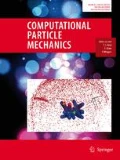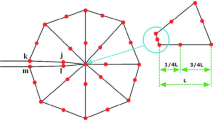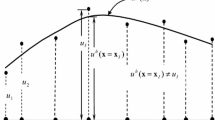Abstract
The functionally graded materials (FGMs), characterized by spatially varying material properties, have been used in a wide range of engineering applications (i.e., aerospace, nuclear reactor and microelectronics) in high temperature and high-temperature gradient environments. The prediction of crack behavior under severe temperature conditions is essential for the safety and long-term service life of such critical components. In this paper, a novel thermal–mechanical coupling model for FGMs is proposed, which consists of a thermal part for the temperature field computation and the combined finite–discrete element method part for the crack evolution modeling. The spatially dependent material characteristics of the FGMs are captured in this model, together with typical property variation functions (quadratic, exponential and trigonometric). The accuracy and robustness of the proposed coupled TM model are validated by numerical tests. Then, this model is applied to investigate the thermal cracking process in FGMs under different kinds of thermal loads. The influence of the crack interaction on crack growth pattern is also discussed. The results show that the proposed method is useful to the fracture mechanics analysis and design of the FGMs structures.



















Similar content being viewed by others
References
Koizumi M (1997) FGM activities in Japan. Composites 28:1–4
Birman V (2007) Modeling and analysis of functionally graded materials and structures. Appl Mech Rev 60(5):42
Shukla A, Jain N, Chona R (2007) A review of dynamic fracture studies in functionally graded materials. Strain 43(2):76–95
Clémence Petit, Palmero P (2018) Functionally graded ceramics for biomedical application: concept, manufacturing, properties. Int J Appl Ceram Technol 15:820–840
Corni I, Ryan MP, Boccaccini AR (2008) Electrophoretic deposition: from traditional ceramics to nanotechnology. J Eur Ceram Soc 28(7):1353–1367
Babaei MH, Chen Z (2015) Transient hyperbolic heat conduction in a functionally graded hollow cylinder. J Thermophys Heat Transfer 24(2):325–330
Kim Jeong-Ho, Paulino G (2007) On fracture criteria for mixed-mode crack propagation in functionally graded materials. Mech Compos Mater Struct 14(4):227–244
Zamani A, Eslami MR (2009) Coupled dynamical thermoelasticity of a functionally graded cracked layer. J Therm Stresses 32(10):969–985
Wang ZW, Zhang Q, Xia LZ, Wu JT, Liu PQ (2015) Stress analysis and parameter optimization of an fgm pressure vessel subjected to thermo-mechanical loadings. Proc Eng 130:374–389
Noda N, Wang BL (2002) Transient thermoelastic responses of functionally graded materials containing collinear cracks. Eng Fract Mech 69(14–16):1791–1809
Guo LC, Noda NWuL (2008) Thermal fracture model for a functionally graded plate with a crack normal to the surfaces and arbitrary thermomechanical properties. Compos Sci Technol 68(3–4):1034–1041
Petrova V, Schmauder S (2012) Interaction of a system of cracks with an interface crack in functionally graded/homogeneous bimaterials under thermo-mechanical loading. Comput Mater Sci 64(64):229–233
Eshraghi I, Soltani N, Dag N (2018) Hyperbolic heat conduction based weight function method for thermal fracture of functionally graded hollow cylinders. Int J Press Vessels Pip 165:249–362
Kawasaki A, Watanabe R (2002) Thermal fracture behavior of metal/ceramic functionally graded materials. Eng Fract Mech 69(14–16):1713–1728
Abanto-Bueno J, Lambros J (2006) An experimental study of mixed mode crack initiation and growth in functionally graded materials. Exp Mech 46(2):179–196
Qin LY, Wang W, Yang G (2012) Experimental study on laser metal deposition of fgms with ultrasonic vibration. Appl Mech Mater 5:271–272
Gilbert A, Kokini K, Sankarasubramanian S (2008) Thermal fracture of zirconia-mullite composite thermal barrier coatings under thermal shock: an experimental study. Surf Coat Technol 10(202):2152–2161
Burlayenko VN, Altenbach H, Sadowski T, Dimitrova SD (2016) Computational simulations of thermal shock cracking by the virtual crack closure technique in a functionally graded plate. Comput Mater Sci 116:11–21
Shaghaghi MA, Marco A (2018) Thermoelastic analysis of surface cracks in fgms hollow cylinders using the interaction energy integral method. Eng Fract Mech 202:103–115
Ekhlakov A, Khay O, Zhang C, Sladek J, Sladek V, Gao XW (2012) Thermoelastic crack analysis in functionally graded materials and structures by a bem. Fatigue Fract Eng Mater Struct 35:724–776
Zhang BJ, Yang Y, Gao XW, Zhang C (2018) Dynamic fracture analysis of functionally graded materials under thermal shock loading by using the radial integration boundary element method. Compos Struct 201:468–476
Liu P, Yu T, Bui TQ, Zhang C, Xu Y, Lim CW (2014) Transient thermal shock fracture analysis of functionally graded piezoelectric materials by the extended finite element method. Int J Solids Struct 51(11–12):2167–2182
Rokhi MM, Shariati M (2013) Implementation of the extended finite element method for coupled dynamic thermoelastic fracture of a functionally graded cracked layer. J Braz Soc Mech Sci Eng 35(2):69–81
Zhang HH, Liu SM, Han SY, Fan LF (2018) Modeling of 2d cracked FGMs under thermo-mechanical loadings with the numerical manifold method. Int J Mech Sci 148:103–117
Munjiza A (2004) The combined finite–discrete element method. Wiley, Chichester
Lisjak A, Mahabadi O, He L, Tatone B, Kaifosh P et al (2018) Acceleration of a 2D/3D finite–discrete element code for geomechanical simulations using general purpose GPU computing. Comput Geotech 100:84–96
Lei Q, Latham JP, Xiang J (2016) Implementation of an empirical joint constitutive model into finite–discrete element analysis of the geomechanical behaviour of fractured rocks. Rock Mech Rock Eng 49(12):4799–4816
Yan CZ, Zheng H, Sun GH, Ge XR (2016) Combined finite–discrete element method for simulation of hydraulic fracturing. Rock Mech Rock Eng 49(4):1389–1410
Liu QS, Sun L (2019) Simulation of coupled hydro-mechanical interactions during grouting process in fractured media based on the combined finite–discrete element method. Tunn Undergr Space Technol 84:472–486
Munjiza A, Andrews KRF, White JK (1999) Combined single and smeared crack model in combined finite–discrete element analysis. Int J Numer Meth Eng 44(1):41–57
Munjiza A, Andrews KRF (1998) NBS contact detection algorithm for bodies of similar size. Int J Numer Meth Eng 43(1):131–149
Lisjak A, Grasselli G, Vietor T (2014) Continuum-discontinuum analysis of failure mechanisms around unsupported circular excavations in anisotropic clay shales. Int J Rock Mech Min Sci 65:96–115
Sutradhar A, Paulino GH (2004) The simple boundary element method for transient heat conduction in functionally graded materials. Comput Methods Appl Mech Eng 193(42–44):4511–4539
Cao LL, Qin QH, Zhao N (2012) Hybrid graded element model for transient heat conduction in functionally graded materials. Acta Mech Sin (English Series) 28(1):128–139
Takeuti Y, Furukawa T (1981) Some considerations on thermal shock problems in a plate. J Appl Mech 48(1):113
Jiao YY, Zhang XL, Zhang HH, Li HB, Yang SQ, Li JC (2015) A coupled thermo-mechanical discontinuum model for simulating rock cracking induced by temperature stresses. Comput Geotech 67:142–149
Farouki OT (1981) The thermal properties of soils in cold regions. Cold Reg Sci Technol 5(1):67–75
Shen B, Stephansson O, Rinne M (2014) Modelling rock fracturing processes. Springer, Dordrecht
Tan X, Chen W, Wu G, Yang J (2013) Numerical simulations of heat transfer with ice–water phase change occurring in porous media and application to a cold-region tunnel. Tunn Undergr Space Technol 38:170–179
Yvonnet J, He QC, Zhu QZ, Shao JF (2011) A general and efficient computational procedure for modelling the kapitza thermal resistance based on xfem. Comput Mater Sci 50(4):1220–1224
Jung J, Do BC, Yang QD (2016) Augmented finite–element method for arbitrary cracking and crack interaction in solids under thermo-mechanical loadings. Philos Trans R Soc A Math Phys Eng Sci 374(2071):20150282
Hattiangadi A, Siegmund T (2005) A numerical study on interface crack growth under heat flux loading. Int J Solids Struct 42(24–25):6335–6355
He J, Liu QS, Wu ZJ, Xu XY (2018) Modelling transient heat conduction of granular materials by numerical manifold method. Eng Anal Bound Elem 86:45–55
Itasca Consulting Group Inc (2005) Code UDEC. User’s Guide, Minnesota, USA
Iesan D (2004) Thermoelastic models of continua. Kluwer Academic Publishers, Dordrecht
Carslaw HS, Jaeger JC (1959) Conduction of heat in solids, 2nd edn. Clarendon Press, Oxford, p 414
Sladek J, Sladek V, Zhang C (2003) Transient heat conduction analysis in functionally graded materials by the meshless local boundary integral equation method. Comput Mater Sci 28(3–4):494–504
Wang BL, Tian ZH (2005) Application of finite element–finite difference method to the determination of transient temperature field in functionally graded materials. Finite Elem Anal Des 41(4):335–349
Feng YT, Han K, Owen DRJ (2009) Discrete thermal element modelling of heat conduction in particle systems: pipe-network model and transient analysis. Powder Technol 193(3):248–256
Fujimoto T, Noda N (2001) Influence of the compositional profile of functionally graded material on the crack path under thermal shock. J Am Ceram Soc 84(7):1480–1486
Zamani A, Eslami MR (2010) Implementation of the extended finite element method for dynamic thermoelastic fracture initiation. Int J Solids Struct 47(10):1392–1404
Kawasaki A, Watanabe R (1997) Effect of gradient microstructure on thermal shock crack extension in metal/ceramic functionally graded materials. In: Proceedings of the 4th international symposium on functionally graded materials, pp 143–148
Huang H, Meakin P, Malthe-Sorenssen A (2016) Physics-based simulation of multiple interacting crack growth in brittle rocks driven by thermal cooling. Int J Numer Anal Meth Geomech 40:2163–2177
Cheng F (2013) Analysis of fracture behavior of metal/ceramic functionally graded materials under thermal stress. Adv Mater Res 750–752:2200–2205
Bahr HA, Fischer G, Weiss HJ (1986) Thermal-shock crack patterns explained by single and multiple crack propagation. J Mater Sci 21(8):2716–2720
Bahr HA, Weiss Hans-Jürgen, Bahr U, Hofmann M, Fischer G, Lampenscherf S et al (2010) Scaling behavior of thermal shock crack patterns and tunneling cracks driven by cooling or drying. J Mech Phys Solids 58(9):1411–1421
Acknowledgements
This work was supported by the National Key Research and Development Program of China (Grant No. 2017YFC1501300), NSERC/Energi Simulation Industrial Research Chair program and Ph.D. Short-time Mobility Program of Wuhan University. The authors would like to thank Prof. Munjiza for the use of the Y code. The proposed Y-FGM™ is based on the Y code. The authors would also like to thank the anonymous reviewers for their constructive comments and suggestions.
Author information
Authors and Affiliations
Corresponding author
Ethics declarations
Conflict of interest
The authors declare that they have no conflict of interest.
Additional information
Publisher's Note
Springer Nature remains neutral with regard to jurisdictional claims in published maps and institutional affiliations.
Appendix A
Appendix A
Under the steady-state condition, the heat flux q is the same in the domain, and the temperature remains unchanged. Thus, the thermal gradient at coordinate x can be calculated as:
where k(x) = k0f(x), here f(x) is the thermal conductivity variation function.
Considering the temperature boundary condition on the left and right sides of the plate, we can have:
where Tl and T0 are temperature at x = l and x = 0, respectively.
Substituting the variation functions [Eqs. (4–6) into Eq. (24)], the exact solution for the constant heat flux and steady temperature field for different variation functions can be obtained, as illustrated in Table 3. Then, the effective heat conductivity (EHC) [49], defined as the amount of heat flux flow into unit area under unit temperature difference, can be calculated as:
Rights and permissions
About this article
Cite this article
Sun, L., Grasselli, G., Liu, Q. et al. Thermal cracking simulation of functionally graded materials using the combined finite–discrete element method. Comp. Part. Mech. 7, 903–917 (2020). https://doi.org/10.1007/s40571-019-00290-9
Received:
Revised:
Accepted:
Published:
Issue Date:
DOI: https://doi.org/10.1007/s40571-019-00290-9




